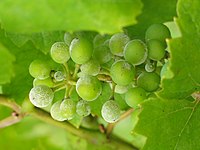
Alka(e)ne synthesis in Cupriavidus necator boosted by the expression of endogenous and heterologous ferredoxin–ferredoxin reductase systems
Sign Up to like & getrecommendations! Published in 2018 at "Biotechnology and Bioengineering"
DOI: 10.1002/bit.26805
Abstract: To boost aldehyde deformylating oxygenase (ADO) activity in a Cupriavidus necator strain expressing a synthetic alkane pathway, the expression of two ferredoxin–ferredoxin reductase systems was tested. The genes of a native fd/FNR‐like system were identified… read more here.
Keywords: necator; ferredoxin; production; ferredoxin ferredoxin ... See more keywords

Gram‐scale production of the sesquiterpene α‐humulene with Cupriavidus necator
Sign Up to like & getrecommendations! Published in 2021 at "Biotechnology and Bioengineering"
DOI: 10.1002/bit.27788
Abstract: Terpenoids have an impressive structural diversity and provide valuable substances for a variety of industrial applications. Among terpenes, the sesquiterpenes (C15) are the largest subclass with bioactivities ranging from aroma to health promotion. In this… read more here.
Keywords: necator; gram scale; production; scale production ... See more keywords

Polyhydroxyalkanoate production from sucrose by Cupriavidus necator strains harboring csc genes from Escherichia coli W
Sign Up to like & getrecommendations! Published in 2017 at "Applied Microbiology and Biotechnology"
DOI: 10.1007/s00253-017-8470-7
Abstract: Cupriavidus necator H16 is the most promising bacterium for industrial production of polyhydroxyalkanoates (PHAs) because of their remarkable ability to accumulate them in the cells. With genetic modifications, this bacterium can produce poly(3-hydroxybutyrate-co-3-hydroxyhexanoate) (PHBHHx), which… read more here.
Keywords: genes escherichia; necator; csc genes; production ... See more keywords

Fine mapping of Ren3 reveals two loci mediating hypersensitive response against Erysiphe necator in grapevine
Sign Up to like & getrecommendations! Published in 2017 at "Euphytica"
DOI: 10.1007/s10681-017-1857-9
Abstract: Grapevine (Vitis vinifera L.) is economically very important for the production of wine, table grapes and raisins. However, grapevine is threatened by a brought range of pathogens. A destructive disease worldwide is powdery mildew caused… read more here.
Keywords: necator; erysiphe necator; grapevine; ren3 ... See more keywords

Chemoautotroph Cupriavidus necator as a potential game-changer for global warming and plastic waste problem: A review.
Sign Up to like & getrecommendations! Published in 2021 at "Bioresource technology"
DOI: 10.1016/j.biortech.2021.125693
Abstract: Cupriavidus necator, a versatile microorganism found in both soil and water, can have both heterotrophic and lithoautotrophic metabolisms depending on environmental conditions. C. necator has been extensively examined for producing Polyhydroxyalkanoates (PHAs), the promising polyester… read more here.
Keywords: necator; waste; necator potential; cupriavidus necator ... See more keywords

Heterologous expression of phaC2 gene and poly-3-hydroxyalkanoate production by recombinant Cupriavidus necator strains using canola oil as carbon source.
Sign Up to like & getrecommendations! Published in 2018 at "New biotechnology"
DOI: 10.1016/j.nbt.2017.08.001
Abstract: Many heterologous transformation studies have been carried out using the Cupriavidus necator PHB-4 strain to investigate the expression characteristics of various polyhydroxyalkanoate (PHA) synthase enzymes. In this study, we generated a recombinant C. necator PHB-4… read more here.
Keywords: necator; phac2 gene; expression; gene ... See more keywords

Utilization of Dielectrophoresis for the Quantification of Rare Earth Elements Adsorbed on Cupriavidus necator
Sign Up to like & getrecommendations! Published in 2019 at "ACS Sustainable Chemistry & Engineering"
DOI: 10.1021/acssuschemeng.9b03878
Abstract: A new method of quantifying rare earth elements (REEs): light REEs (neodymium—Nd3+ and samarium—Sm3+) and heavy REE (europium—Eu3+) was investigated by utilizing native Cupriavidus necator as the biosorbent and dielectrophoresis as the quantification technique.C. necator… read more here.
Keywords: necator; earth elements; dielectrophoresis quantification; rare earth ... See more keywords

A rapid glove-based inoculum sampling technique to monitor Erysiphe necator in commercial vineyards.
Sign Up to like & getrecommendations! Published in 2023 at "Plant disease"
DOI: 10.1094/pdis-02-23-0216-re
Abstract: Information on the presence and severity of grape powdery mildew (GPM), caused by Erysiphe necator, has long been used to guide management decisions. While recent advances in the available molecular diagnostic assays and particle samplers… read more here.
Keywords: glove swabs; necator; commercial vineyards; erysiphe necator ... See more keywords

Effects of Nighttime Applications of Germicidal Ultraviolet Light upon Powdery Mildew (Erysiphe necator), Downy Mildew (Plasmopara viticola), and Sour Rot of Grapevine.
Sign Up to like & getrecommendations! Published in 2022 at "Plant disease"
DOI: 10.1094/pdis-04-22-0984-re
Abstract: Nighttime applications of germicidal ultraviolet were evaluated as a means to suppress three diseases of grapevine. In laboratory studies, UV-C light (peak 254 nm, FWHM 5 nm) applied during darkness strongly inhibited the germination of… read more here.
Keywords: sour rot; twice weekly; necator; nighttime applications ... See more keywords

Development of a PNA-LNA-LAMP assay to detect a SNP associated with QoI resistance in Erysiphe necator.
Sign Up to like & getrecommendations! Published in 2023 at "Plant disease"
DOI: 10.1094/pdis-09-22-2027-re
Abstract: The repetitive use of quinone outside inhibitor fungicides (QoIs, strobilurins; Fungicide Resistance Action Committee (FRAC) 11) to manage grape powdery mildew has led to development of resistance in Erysiphe necator. While several point mutations in… read more here.
Keywords: lna lamp; necator; qoi resistance; resistance ... See more keywords

Timing Fungicide Application Intervals Based on Airborne Erysiphe necator Concentrations.
Sign Up to like & getrecommendations! Published in 2017 at "Plant disease"
DOI: 10.1094/pdis-12-16-1727-re
Abstract: Management of grape powdery mildew (Erysiphe necator) and other polycyclic diseases relies on numerous fungicide applications that follow calendar or model-based application intervals, both of which assume that inoculum is always present. Quantitative molecular assays… read more here.
Keywords: necator; application; fungicide applications; application intervals ... See more keywords